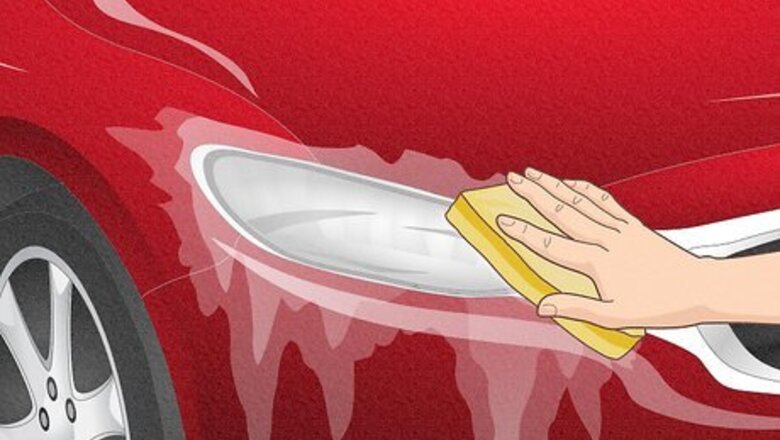
views
Sanding the Clear Coat Off
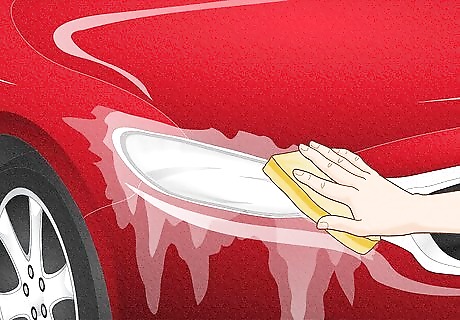
Wash the plastic car part you’re removing the clear coat from. Clean the area well using soapy water and a sponge, then rinse off the soap suds thoroughly. Wipe the area dry using a clean towel or let it air dry completely, then you’re ready to really get started. If you don’t clean the plastic part well before you get started, you might rub bits of dirt and grit into the plastic while you’re sanding it and cause scratching and damage that’s more work to fix. If you don’t have a sponge, you can use a clean rag or cloth instead. You could also take your car through a car wash if you’re removing the clear coat from a plastic part attached to your car. Clear coat is a type of clear paint used on cars, so this process applies only to clear-coated plastic car parts, such as lights.
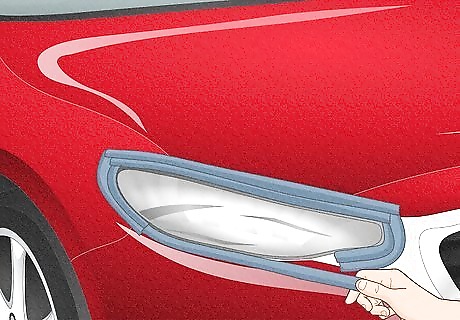
Tape off the area surrounding the plastic with blue painter’s tape. Carefully apply blue painter’s tape around the edges of the plastic part you’re removing the clear coat from to protect the surrounding surfaces from scratches. Be as precise as possible and stick the tape right up against the edge of the plastic, without covering any of the plastic itself. For example, if you’re removing the clear coat from a headlight, mask around all the surrounding metal using blue painter’s tape.
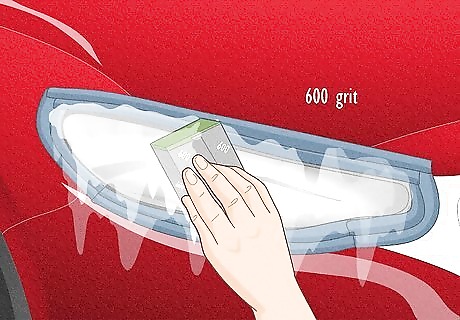
Wet-sand the plastic by hand using soapy water and 600-grit sandpaper. Spray down the entire clear-coated plastic surface with soapy water in a spray bottle. Wrap a piece of 600-grit wet and dry sandpaper around a sanding block. Rub the sandpaper back and forth in all directions over the entire plastic surface for about 5-10 minutes to remove most of the clear coat. You can just mix water with a couple spoonfuls of liquid dish detergent in any spray bottle to make a soap-water solution for wet sanding the clear coat off. Spray more soapy water on the plastic part as you’re sanding if the plastic dries out. Try to keep it wet at all times during sanding. Make sure you sand right up to all the edges of the plastic and not just in the middle.
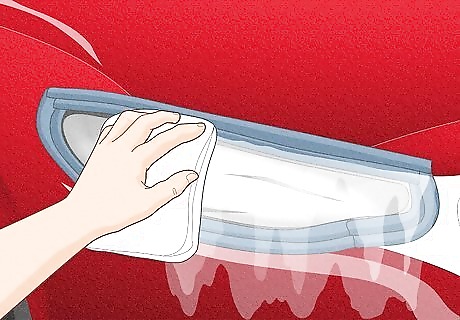
Wipe off the plastic after the first round of sanding using a clean towel. Rub all the soap-water solution and dust from sanding off the plastic to clean it off. This prepares it for the next round of sanding. You can rinse the plastic off with a little plain water before you wipe it down if it helps get rid of all the sanding dust. The plastic should look uniformly foggy and dull all over after you sand off all the clear coat. If you notice any spots that still look clear, wet the spots with soapy water again and go back over those areas with your 600-grit sandpaper until everything looks uniform.
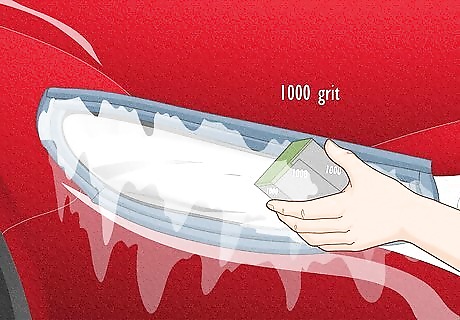
Switch to 1000-grit sandpaper and repeat the sanding process. Wrap a piece of 1000-grit sandpaper around your sanding block. Spray down the plastic surface using your soap-water solution and sand it all over using the 1000-grit sandpaper. Keep the plastic wet and rub the sandpaper back and forth while holding it flat against the surface. The 1000-grit sandpaper removes any remaining traces of the clear coat and starts smoothing out the plastic. Spend about 5-10 minutes on this second round of sanding.
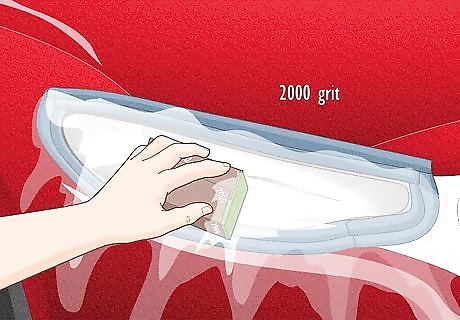
Clean off the plastic and repeat the process using 2000-grit sandpaper. Wipe off the soap-water solution and sanding dust using your towel. Spray it down again with your soapy water, wrap a piece of 2000-grit sandpaper around your sanding block, and rub it back and forth all over the plastic in all directions. The 2000-grit sandpaper finishes smoothing out the plastic to get it ready for polishing. Just like with the first 2 rounds of sanding, you only need to spend about 5-10 minutes using the 2000-grit sandpaper. The plastic should look completely cloudy and feel very smooth at this point.
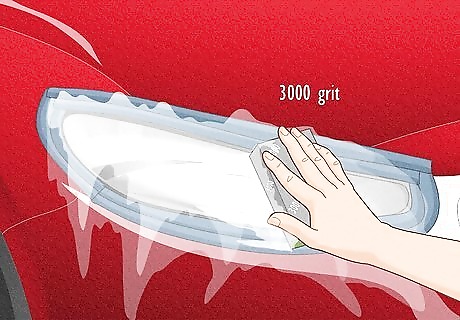
Repeat the process with 3000-grit sandpaper. Wipe the plastic clean using your towel. Wet it completely using your spray bottle of soapy water. Wrap a piece of 3000-grit sandpaper around your sanding block and rub it all over the plastic surface in each direction, keeping the plastic wet as you sand, until it starts to clear up and look shiny again. Wipe the plastic clean again with your towel when you finish. This round of sanding may take longer than the previous rounds. It’s the last sanding step before polishing the plastic, so take your time and make sure you get a really clear, smooth finish before moving on. For example, if you’re doing this on a headlight, you can stop once you can see through the entire headlight again.
Polishing the Plastic
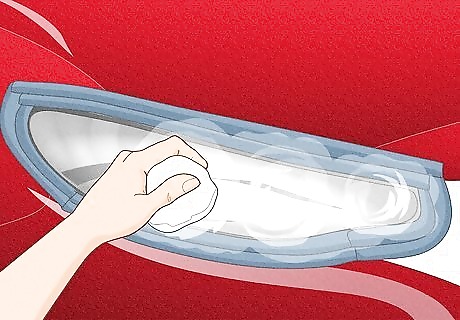
Apply a coat of lens polish using a cotton cloth. Dip a clean cotton cloth into a tub of lens polish. Rub it onto the plastic surface using firm circular motions until you cover the entire plastic piece in an even coat of polish. If you don’t have a cotton cloth, you can cut up an old cotton T-shirt and use that to apply the polish.

Buff the polish off using a clean microfiber cloth. Grab a clean microfiber cloth in your hands. Rub the cloth or wheel all over the plastic surface in firm circular motions until you buff off all the polish and the plastic looks clear and shiny. You can stop polishing at this point if you’re happy with the finish or repeat the process to apply and buff off another coat of polish. You could also put a buffing wheel on an orbital power tool and use that to buff the polish off instead of doing it by hand with a cloth.

Apply a coat of carnauba wax to the plastic to protect it. Put a blob of carnauba wax in the middle of a waxing pad and rub it all over the surface of the polished plastic piece. Let the wax sit for about 10 minutes to dry on, then rub off the excess with a clean microfiber cloth or other lint-free cloth. You can also use liquid car wax instead of carnauba wax. You can do this by hand or using a waxing pad attached to an orbital power tool. If you want to apply a new clear coat to the plastic, do it instead of waxing the surface. Both wax and clear coat serve to protect the plastic from scratching and other damage, but clear coating is a much more involved process and isn’t completely necessary.

Peel off the tape from around the plastic. Carefully peel off each piece of blue painter’s tape you stuck to the surrounding surfaces to mask around the plastic. Toss the tape in the trash. You can also remove the tape before or during the buffing stage if it’s getting in the way. The buffing won’t hurt the surrounding surfaces.














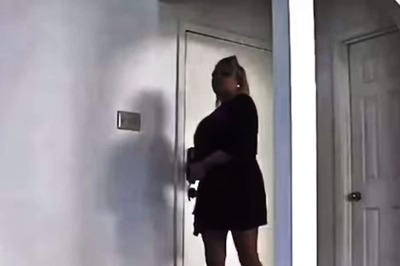




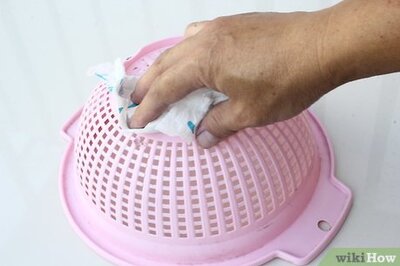
Comments
0 comment